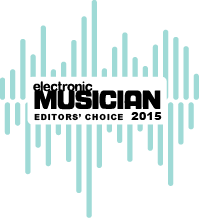Enter
the Matrix
Extreme patching met 12 dual-oscillator voices in one of the most prestigious keyboard synths of the ’80s.
With 27 modulation sources, 47 destinations, 15 filter modes, and five envelopes, it combined the flexibility of a modular synth with the polyphony and programmability demanded by artists like Toto, Vangelis, Prince, and Herbie Hancock. How do you improve upon such an instrument? Matrix-12 V balances absolute authenticity with the flexibility modern music makers need - and then some.
You Can’t Sample This
Our True Analog Emulation® technology models the behavior of every circuit and how they interact. Matrix 12-V is one of its biggest achievements yet.
Your Everything Synth
Whether you make power-pop, electronica, R&B, hip-hop, or a fusion of styles yet to have a name, Matrix-12 V delivers head-turning sounds with remarkable ease.
An Ace in Your Hand
The Matrix could sound like virtually every other analog polysynth of the ’80s — and some digital synths — but no other synth could sound like the Matrix.
Own a Legend
A working Matrix-12 fetches five figures if you can find one. Matrix-12 V offers perfect accuracy at a tiny fraction of the cost, and with modern stability.
Analog in
a digital world
With digital synths like the DX7 and affordable sample-based keyboards just over the horizon, Tom Oberheim and company set out to show the world what a no-holds-barred analog machine could really do.
Echoing Oberheim’s earlier success with the SEM, the project began with a sound expansion module. This was 1984’s Xpander, which had six voices and the same signal path as the Matrix-12, which would arrive just a year later.
MIDI created a market for modules that could augment the capabilities that synth players already owned without adding the bulk of another black-and-white keyboard to their rigs. The Xpander was designed by engineers Marcus Ryle (who would later invent the Alesis® ADAT) and Michael Doidic, and became an instant hit.
Discover the history of Matrix-12
In part this was simply because it sounded so good and had a far deeper modulation matrix than anything ever seen in a self-contained “slab” synth. But there’s also the fact that MIDI was new and the talk of the industry, and touring and session keyboardists wanted to advertise that they were now MIDI experts. Stacking an Xpander with your trendy DX-based setup was a bold way to make the statement.
This gave the Oberheim team confidence in the demand for a stand-alone, beefed-up take on the Xpander, and the Matrix-12 was born. It essentially fused two Xpanders with a velocity-sensitive keyboard that also sensed release velocity — a first at the time. It had all the analog fat for which Oberheim was famous, but could produce articulate bells, plucked sounds, wind instruments, and crystalline timbres that otherwise drew players to digital synths. It also didn’t hurt that 12 voices raised the bar from the “pro” standard of six or eight.
Its price of nearly $6,000 made it an option only for accomplished professional musicians and studio owners, but they flocked to buy it and approximately over 1000 units were sold. Many are still in use to this day and it’s rare to find an owner willing to part with theirs - that’s where Matrix-12 V comes in.
Agent
of analog
Matrix-12 V puts your hands on more of the original’s parameters at once.
It’s a playground for quick tweaks during live performance and exacting sound design in the studio.
Because it applied digital control to analog tone generation, the Matrix-12 had three displays and many pages of functions but only six knobs. We thought a sound engine this sensational deserved a lot more.
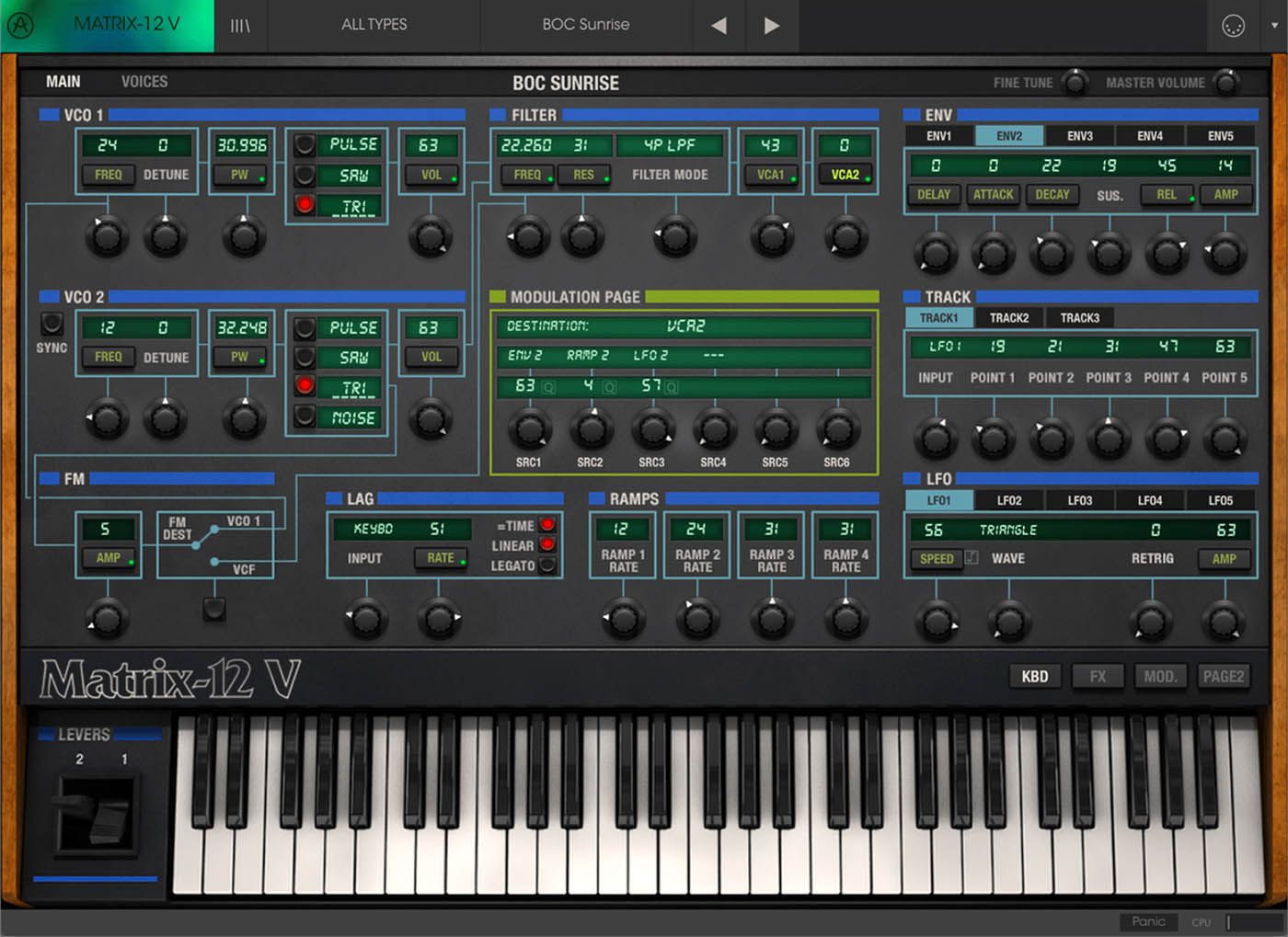
_1
_2
_3
_4
_5
_6
01. Original Oscillators
We began with faithful models of the oscillators, which feature pulse, saw, and triangle waves, PWM, hard sync, FM, and noise.
02. 15 Filters in One
That’s right — multiple pass modes, multiple slopes, and even phase-shifting filters let the Matrix create tones other analog synths can’t.
03. Pushing the Envelope
Why settle for just volume and filter envelopes when you can have five assignable ones? Create sounds that evolve in interesting and unexpected ways.
04. LFO Flexibility
Explore 5 tempo-syncable LFOs ready to apply to anything - and that’s just the tip of Matrix-12 V’s modulation iceberg.
05. Modulation Central
Press any parameter’s button to see all the sources that modulate it, and work with up to six sources at once.
06. Ramp It Up
Four ramp processors are like extra one-stage envelopes you can apply to any signal.
Matrix
Reloaded
More modulation, built-in FX, and a powerful Multi mode make you the architect of amazing sounds.
We dove deep into what makes the Matrix-12 special, put every parameter of it within easy reach, and then freed its analog mind with some reality-bending upgrades.
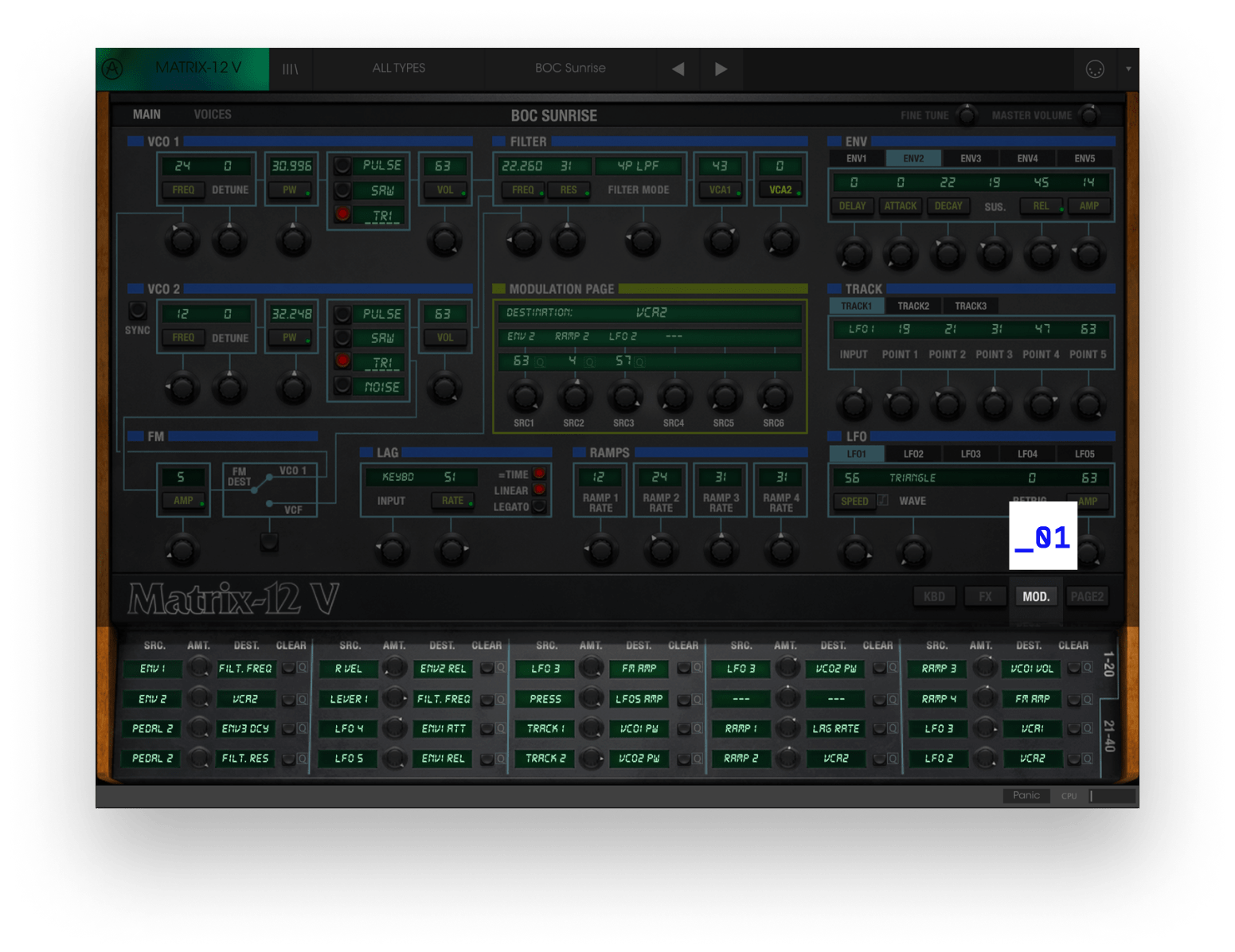
Tweak a superhero’s eye view of every modulation routing in Matrix-12 V at once. With up to 40, you’ll never run out of them.
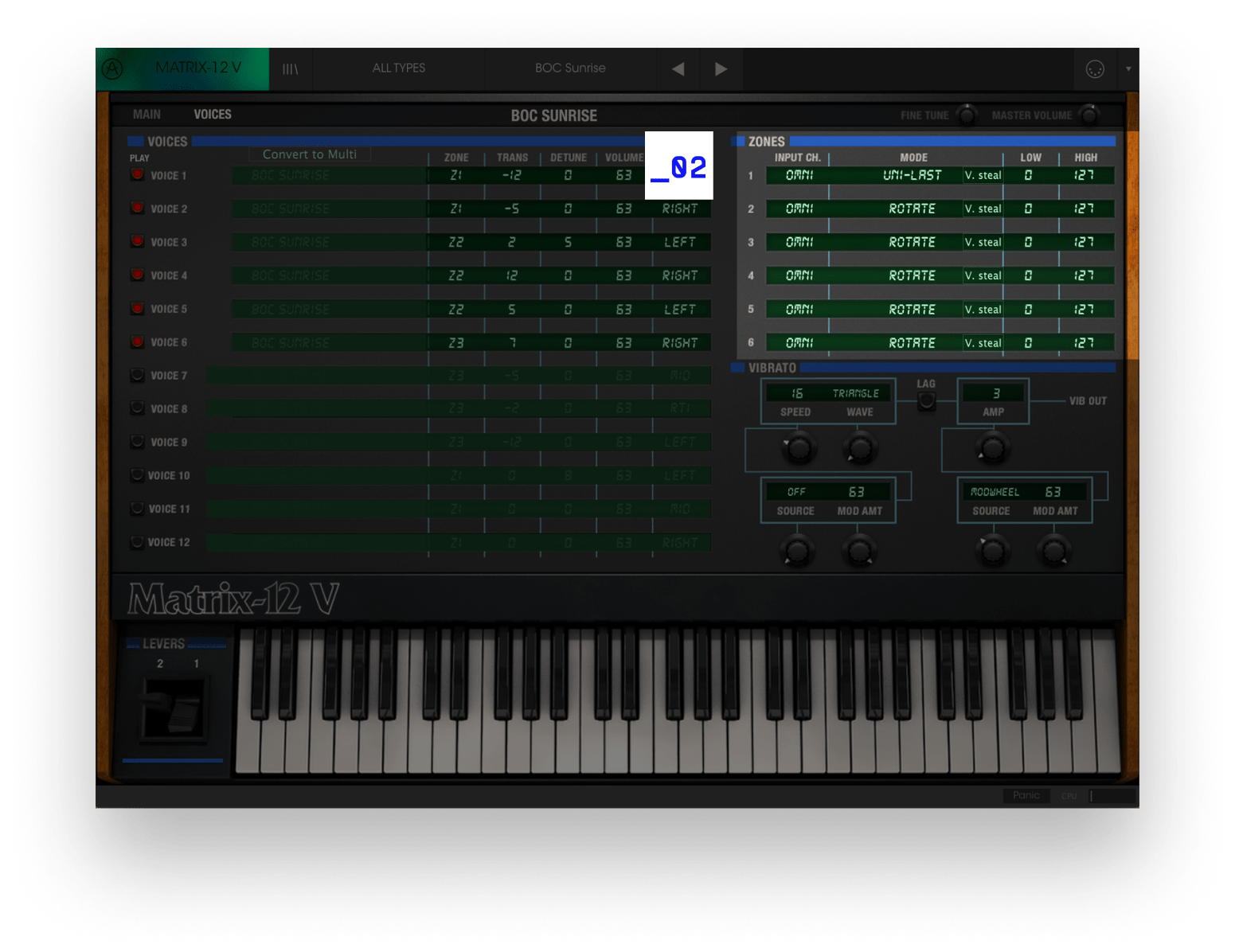
Splits or layers? How about six independent keyboard zones with adjustable range, MIDI channel, and voice allocation?
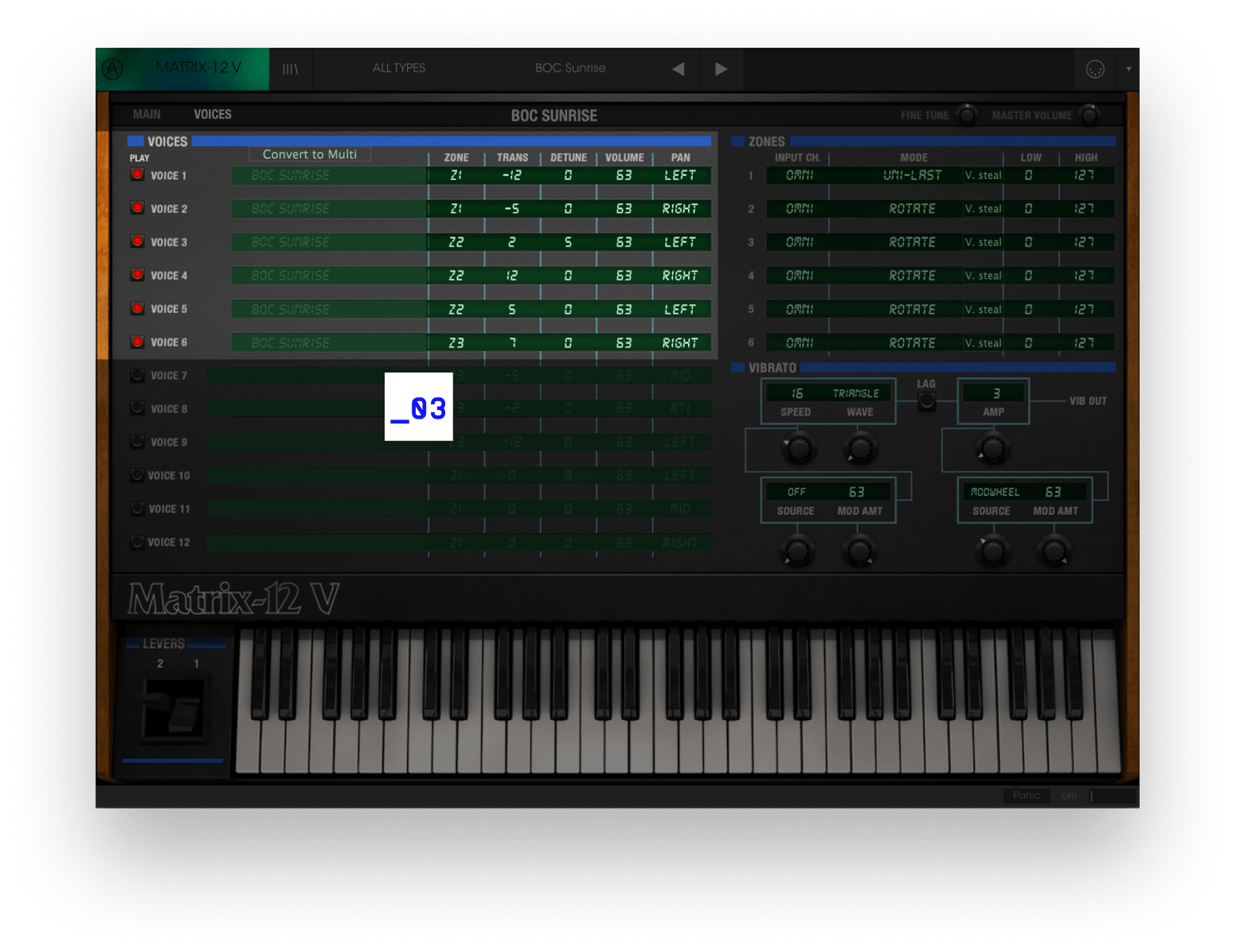
Assign Matrix-12 V’s voices to keyboard zones and transpose, detune, and pan them here. Each voice can play a different patch if you want!
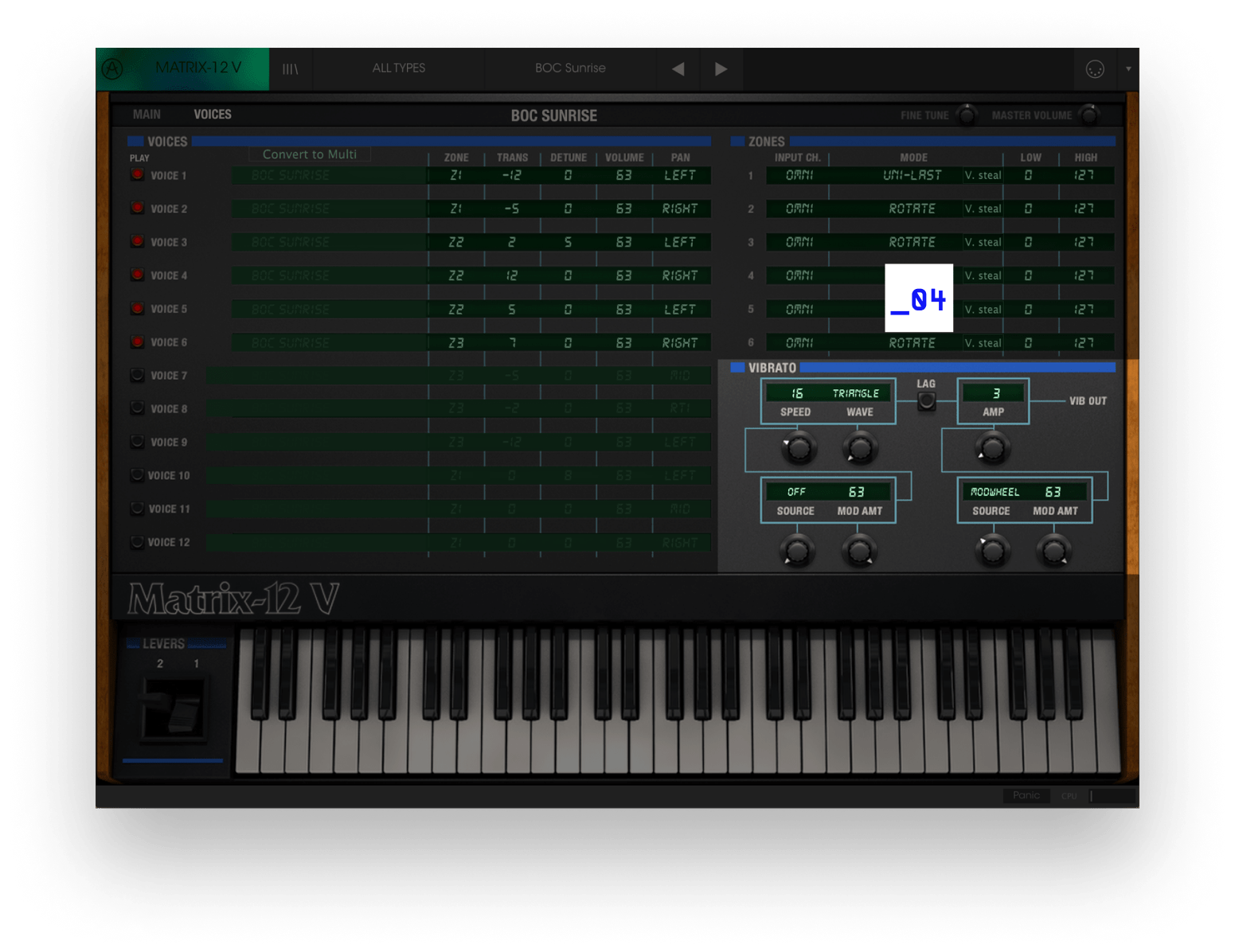
As if five LFOs weren’t enough, an independent vibrato lets you modulate its speed and amount from the mod wheel, a pedal, or aftertouch.

Choose from studio-grade classics including phaser, flanger, chorus, analog delay, stereo ping-pong delay, and lush reverb.
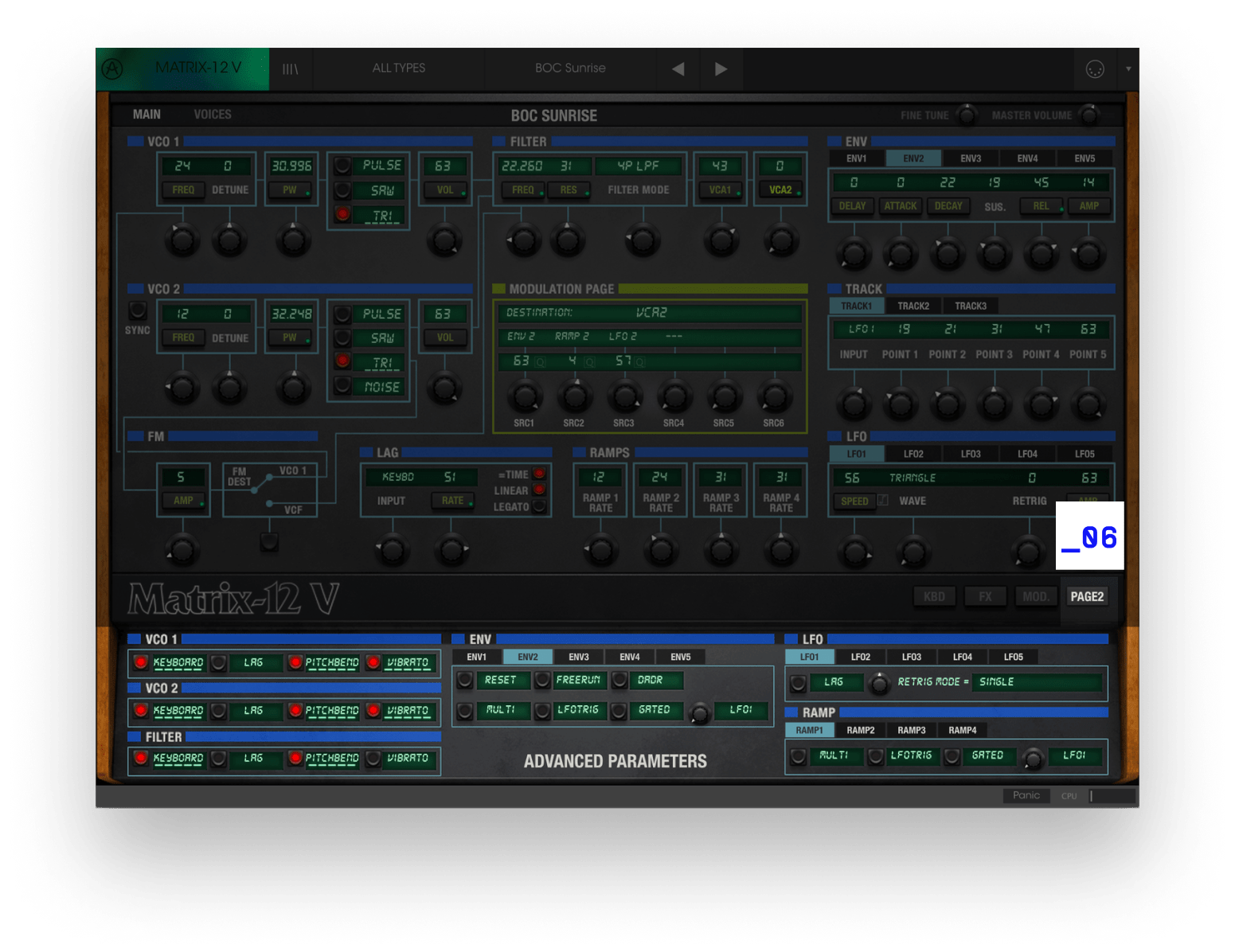
Achieve electron microscope level control over Matrix 12-V’s behavior with the settings located on Page 2.
Snow Patrol
Synthastic guitars
As the bassist and backing vocalist of Snow Patrol, Paul Wilson abounds with the musical know-how on how to complete the emotional spectrum of a song.
Read the StoryHear it
in action
Journey from the neon-lit streets of the 1980s to off-planet colonies and beyond with these audio demos from our community of artists and sound designers, made exclusively using Matrix-12 V sounds.
Escapes
Boele Gerkes
In The Matrix
Lyynk
Selecting Presets
Lyynk
Trap
Greg Savage
Rifts
Victor Morello
A downtempo track with strong eerie feeling, taking advantage of the various filters modes, on board effects and voice parameters to fill the stereo width and audio spectrum.
Sunset
Ambre Basuyaux-Cousin
This minimalist demo features a light lead, the "Mountain Echo" preset, and a filter glide effect which take you to an other dimension.
Brian Molo
Léo Battle
Artistscorner
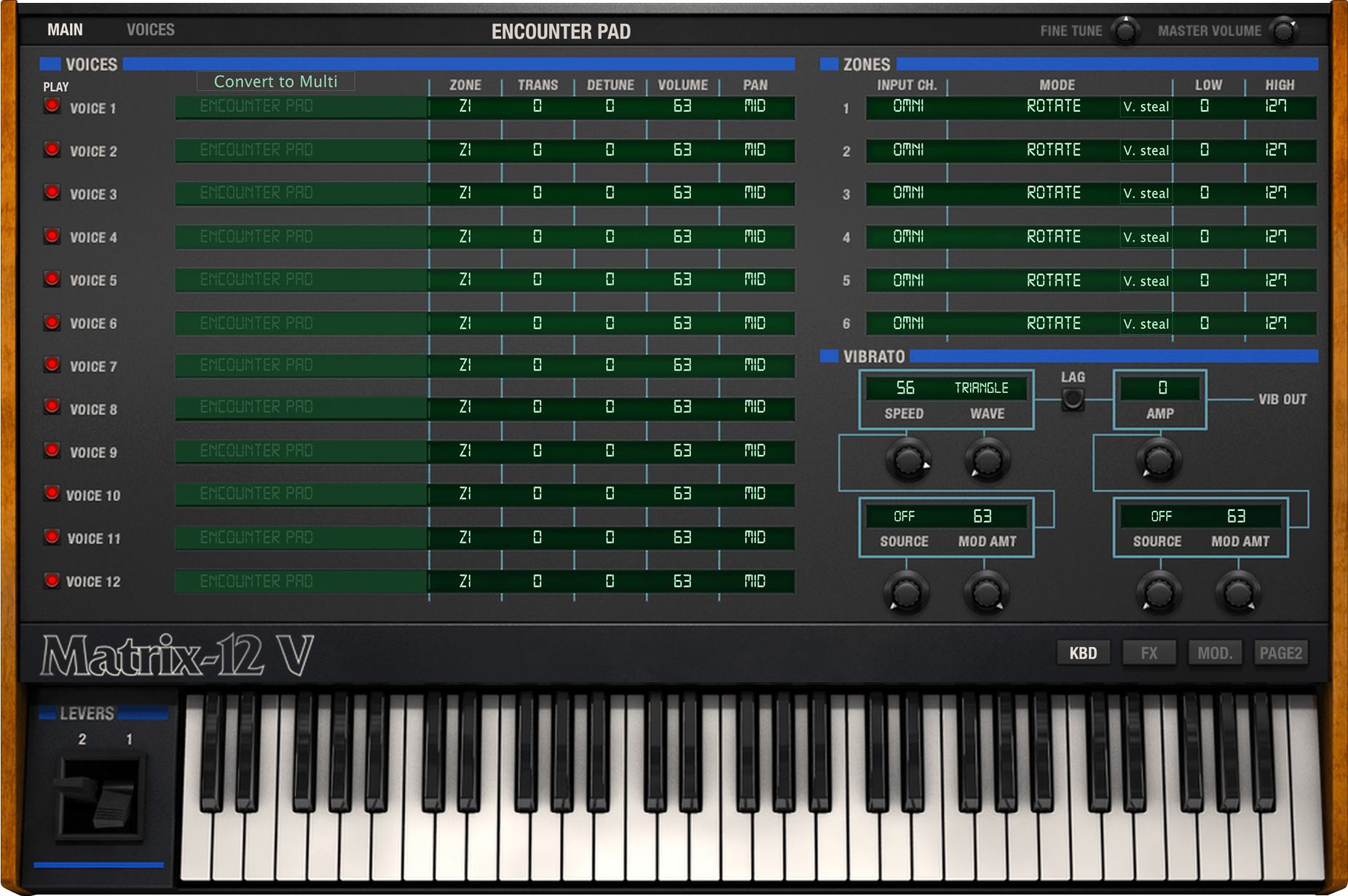
Included in
V collection
Legendary Keyboards Reinvented
This instrument is also part of the V Collection -your complete dream line-up of the legendary synths, organs, pianos and more that made keyboard history. They’re modeled with the most advanced technologies for authentic realism, and enhanced with new creative options. Whether you use it as DAW plugins in the studio or standalone at gigs, V Collection puts the greatest keys of all time at your fingertips for instant inspiration.
Learn More
Die Features
Du brauchst

Integrierte In-App-Tutorials führen dich durch jeden Aspekt des Instruments, von individuellen Parametern bis hin zu Tipps unserer Sounddesigner, damit du dich auf deinen kreativen Moment konzentrieren kannst. Das kann doch nicht so einfach sein, ist es aber!

Mit dem Arturia Software Center kannst du deine Arturia Software an einem Ort herunterladen, organisieren und aktualisieren und alle deine Lizenzen für mehrere Geräte verwalten. Einfacher geht es nicht!

Unsere virtuellen Instrumente und Plug-Ins wurden so entwickelt, dass sie problemlos direkt in dein Setup passen. Unabhängig von deinem Style kannst du jeden Sound erkunden und gleichzeitig die volle Kompatibilität mit den wichtigsten DAWs sowohl unter Windows als auch unter macOS genießen.

Finde sofort den richtigen Sound mit dem intelligenten & optimierten Preset-Browser. Suche nach Schlüsselwörtern, nach Instrumentenart, Musikstil und nach vielem mehr - du kannst sogar deine Favoriten speichern, um diese später schnell aufzurufen.

Egal, ob du mit einer Vollbilddarstellung in unsere klassischen Instrumentenemulationen eintauchen oder kostbaren Bildschirmplatz sparen willst – die Bedienoberflächen für alle virtuellen Arturia-Instrumente können beliebig skaliert werden – ganz nach deinem Geschmack.

Unsere Instrumente sind für den nahtlosen Einsatz mit der Arturia KeyLab-Serie vorkonfiguriert - aber sie funktionieren natürlich auch mit anderen MIDI-Controllern. Und mit dabei: Makros für direkte Sound-Optimierung, einfache DAW-Integration und Standalone-Betrieb.
TAE® Powered
The exclusive analog modeling technology that makes our emulations indistinguishable from the originals.
By accurately mimicking the characteristics of analog oscillators, filters, and soft clipping, we can provide astonishing component-accurate detail and authentic analog charm in equal measure.
Learn more
Gallery
Main Features
Two oscillators, each offering triangle, sawtooth and variable-width pulse wave with PWM.
Oscillator 2 also functions as a white noise generator.
Oscillator 1 or the Filter can be frequency modulated.
Single filter with 15 modes: 4 Low Pass, 3 High Pass, 2 Band Pass modes, Notch and Phase Shift plus four additional "combo" filter modes.
Ultra-powerful modulation matrix with 27 sources and 47 destinations.
Sources include 5 envelopes, 5 LFOs, 4 Ramp, 3 Track generators, Velocity, Pressure, Keyboard follow, and more.
Two insert effect slots with six studio-grade effects available.
12 voices of polyphony like the original instrument
Multitimbral
Works in Standalone, VST, VST3, AU, AAX.
Platform specifications
Windows
- Win 10+ (64bit)
- 4 GB RAM
- Vierkern-CPU, 3.4 GHz (4.0 GHz Turbo-boost)
- 3GB freier Festplattenspeicher
- OpenGL 2.0 kompatible GPU
- ARM Prozessoren werden unter Windows nicht unterstützt
Systemvoraussetzungen
- Arbeitet als Standalone, VST, AAX, Audio Unit, NKS (nur mit 64-Bit DAWs).




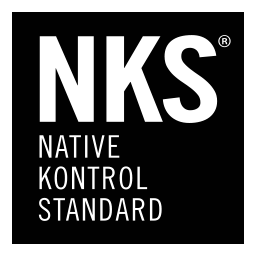
Apple
- Mac OS 11+
- 4 GB RAM
- Vierkern-CPU, 3.4 GHz (4.0 GHz Turbo-boost) oder M1 CPU
- 3GB freier Festplattenspeicher
- OpenGL 2.0 kompatible GPU
Arbeiten mit dem ASC
- Eine elegante und einfache Lösung, die dir bei der Installation, Aktivierung und Aktualisierung der Arturia-Softwareinstrumente hilft.
Alle auf dieser Seite genannten Hersteller- und Produktnamen sind Marken der jeweiligen Eigentümer und stehen in keiner Weise mit Arturia in Verbindung. Die Markenbezeichnungen anderer Hersteller dienen ausschließlich der Kennzeichnung der Produkte derjenigen Hersteller, deren Eigenschaften und Klang bei der Entwicklung analysiert wurden. Alle Namen von Geräten, Entwicklern und Herstellern werden nur zur Veranschaulichung und zu Bildungszwecken aufgeführt und stellen keine Verbindung oder Billigung durch einen Geräte-Entwickler oder -Hersteller dar.
Oberheim® is a registered trademark of Tom Oberheim®, which is in no way associated or affiliated with Arturia. All manufacturer and product names mentioned on this page are trademarks of their respective owners, which are in no way associated or affiliated with Arturia. The trademarks of other manufacturers are used solely to identify the products of those manufacturers whose features and sound were studied during the development. All names of equipment, inventors, and manufacturers have been included for illustrative and educational purposes only, and do not suggest any affiliation or endorsement by any equipment inventor or manufacturer.








